Nursing Report: Australia's CALD Community Healthcare Access Issues
VerifiedAdded on 2021/06/15
|8
|1577
|62
Report
AI Summary
This report examines the challenges faced by Culturally and Linguistically Diverse (CALD) populations in Australia in accessing health and social care services. The report highlights that the CALD community experiences poor health outcomes due to various barriers, including cultural differences, communication issues, and perceived racism. These factors lead to health disparities and limited access to modern healthcare. The report discusses the impact of socioeconomic status, health literacy, and past experiences with healthcare services on access. It also explores the role of informal support networks and the importance of tailored health information. Strategies for addressing these challenges include appointing bilingual workers, using language-appropriate materials, and promoting culturally sensitive health education programs. The report concludes that addressing the needs of CALD communities requires programs tailored to specific language groups, wider dissemination of health information, and collaboration among agencies to improve health outcomes.
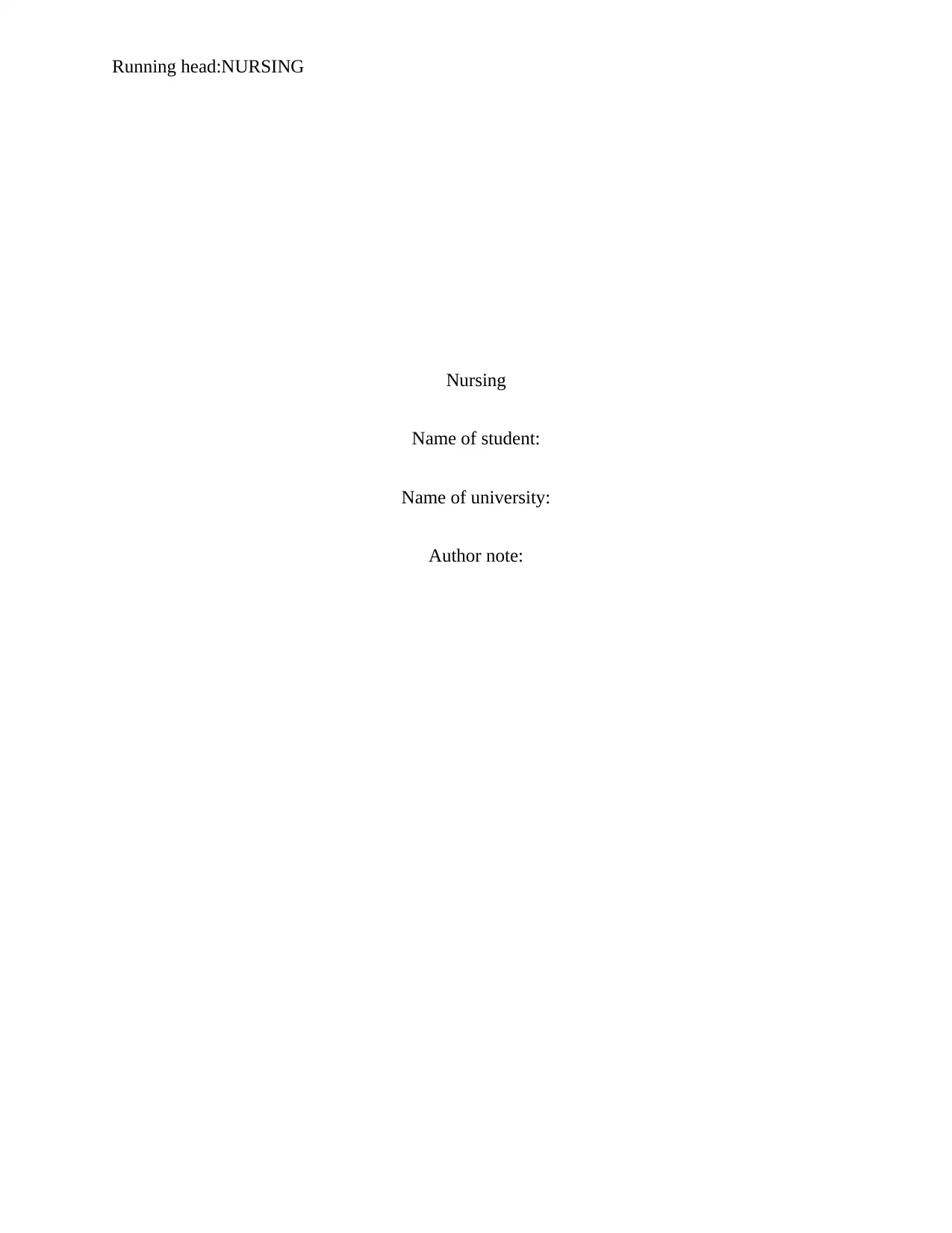
Running head:NURSING
Nursing
Name of student:
Name of university:
Author note:
Nursing
Name of student:
Name of university:
Author note:
Paraphrase This Document
Need a fresh take? Get an instant paraphrase of this document with our AI Paraphraser
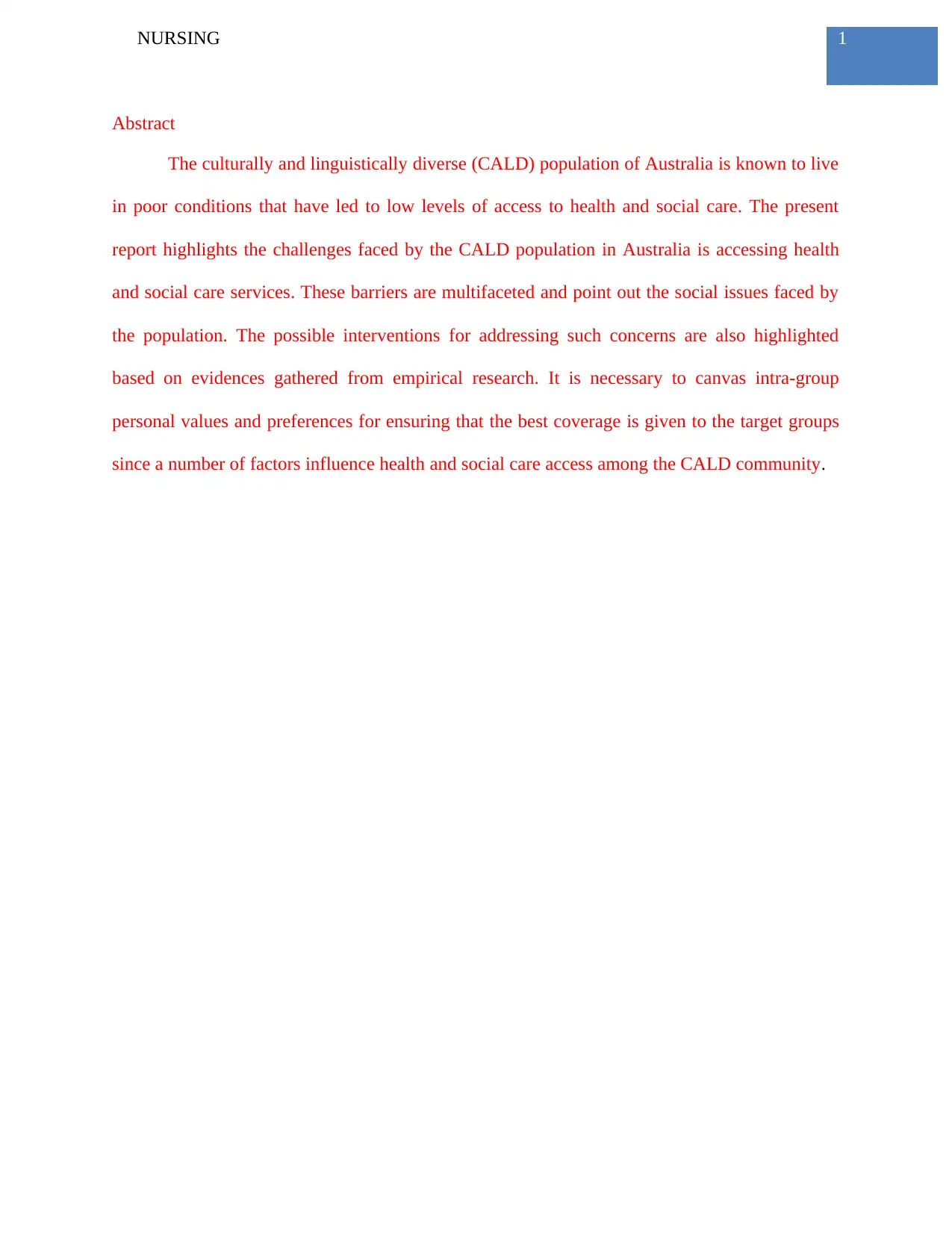
1NURSING
Abstract
The culturally and linguistically diverse (CALD) population of Australia is known to live
in poor conditions that have led to low levels of access to health and social care. The present
report highlights the challenges faced by the CALD population in Australia is accessing health
and social care services. These barriers are multifaceted and point out the social issues faced by
the population. The possible interventions for addressing such concerns are also highlighted
based on evidences gathered from empirical research. It is necessary to canvas intra-group
personal values and preferences for ensuring that the best coverage is given to the target groups
since a number of factors influence health and social care access among the CALD community.
Abstract
The culturally and linguistically diverse (CALD) population of Australia is known to live
in poor conditions that have led to low levels of access to health and social care. The present
report highlights the challenges faced by the CALD population in Australia is accessing health
and social care services. These barriers are multifaceted and point out the social issues faced by
the population. The possible interventions for addressing such concerns are also highlighted
based on evidences gathered from empirical research. It is necessary to canvas intra-group
personal values and preferences for ensuring that the best coverage is given to the target groups
since a number of factors influence health and social care access among the CALD community.
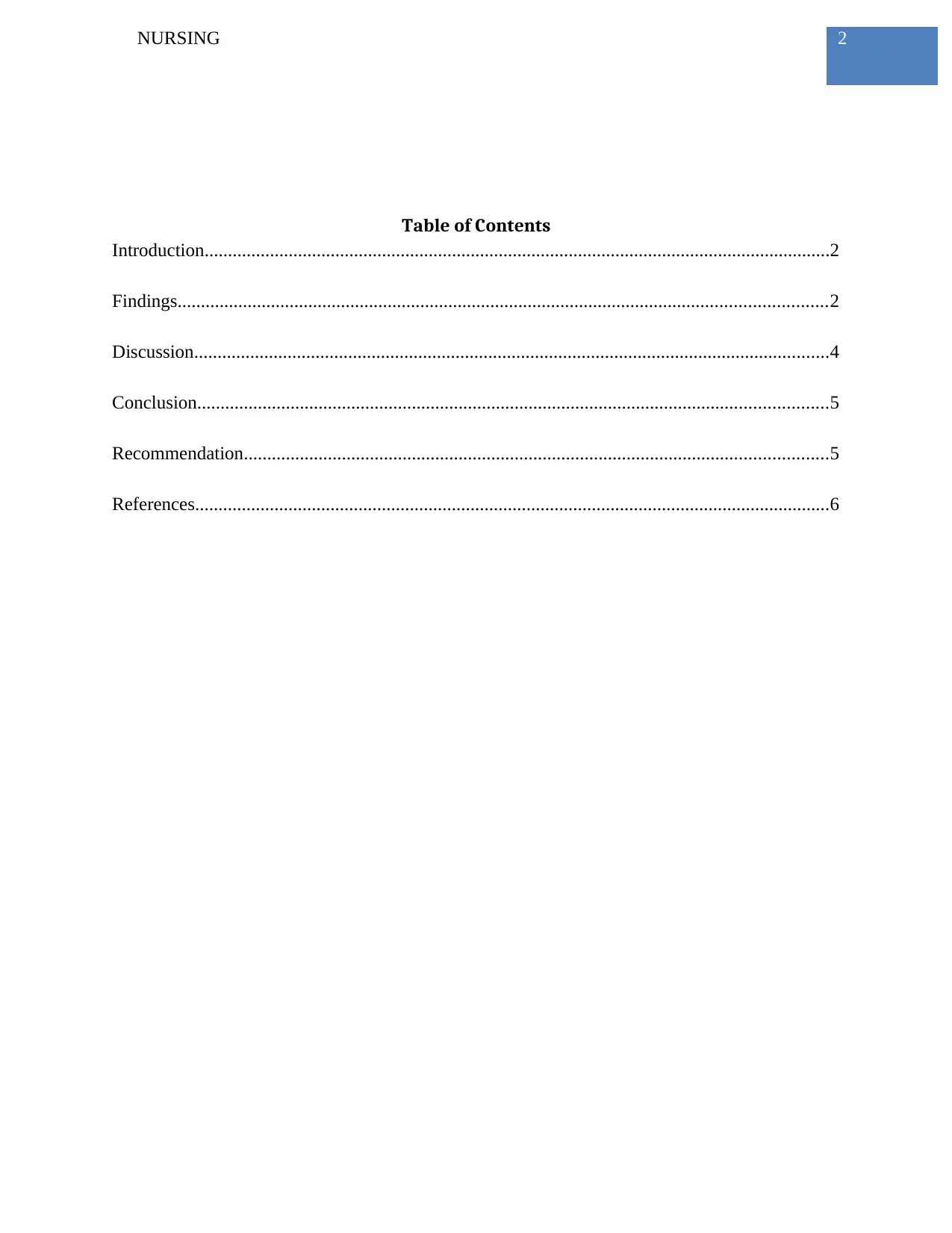
2NURSING
Table of Contents
Introduction......................................................................................................................................2
Findings...........................................................................................................................................2
Discussion........................................................................................................................................4
Conclusion.......................................................................................................................................5
Recommendation.............................................................................................................................5
References........................................................................................................................................6
Table of Contents
Introduction......................................................................................................................................2
Findings...........................................................................................................................................2
Discussion........................................................................................................................................4
Conclusion.......................................................................................................................................5
Recommendation.............................................................................................................................5
References........................................................................................................................................6
⊘ This is a preview!⊘
Do you want full access?
Subscribe today to unlock all pages.

Trusted by 1+ million students worldwide
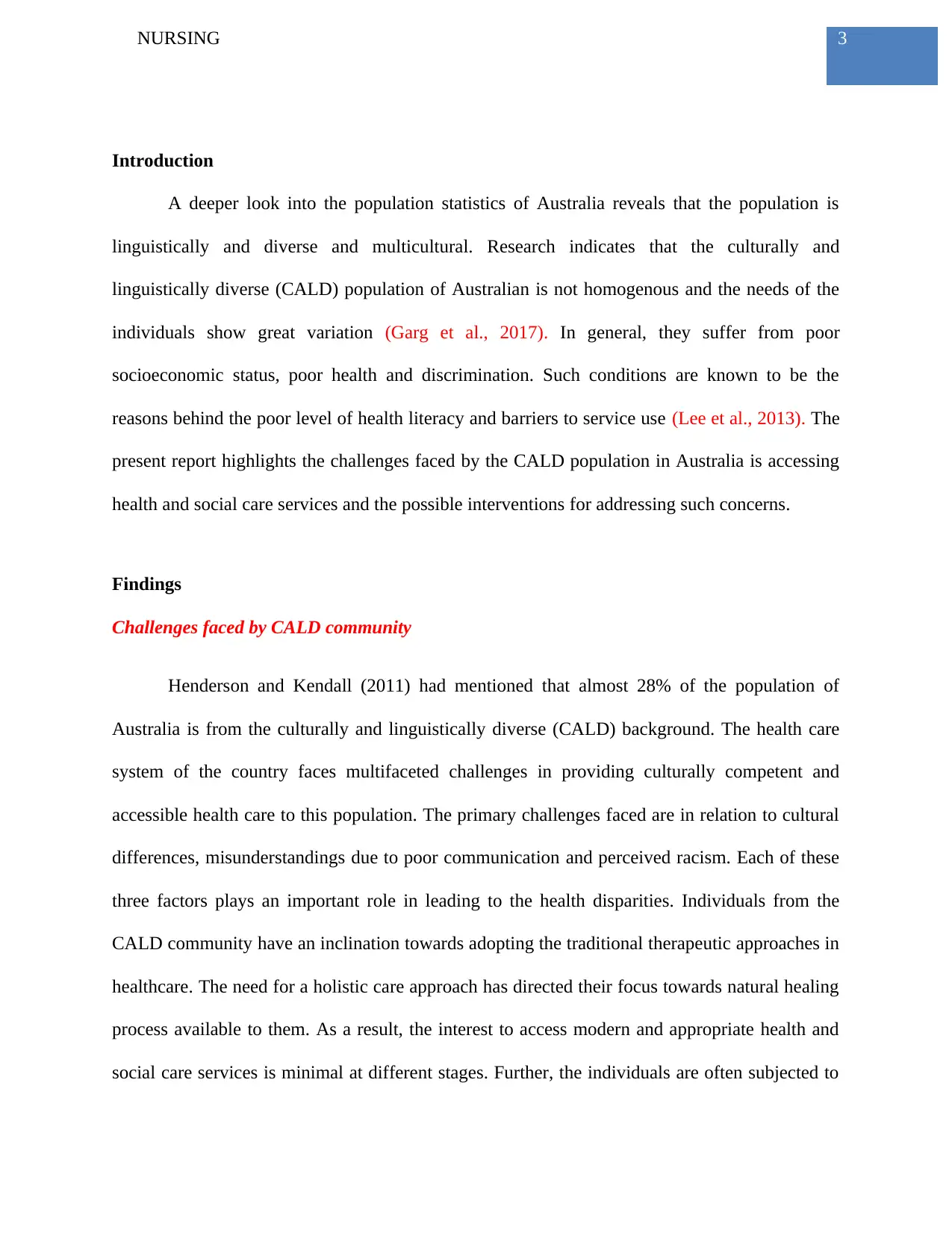
3NURSING
Introduction
A deeper look into the population statistics of Australia reveals that the population is
linguistically and diverse and multicultural. Research indicates that the culturally and
linguistically diverse (CALD) population of Australian is not homogenous and the needs of the
individuals show great variation (Garg et al., 2017). In general, they suffer from poor
socioeconomic status, poor health and discrimination. Such conditions are known to be the
reasons behind the poor level of health literacy and barriers to service use (Lee et al., 2013). The
present report highlights the challenges faced by the CALD population in Australia is accessing
health and social care services and the possible interventions for addressing such concerns.
Findings
Challenges faced by CALD community
Henderson and Kendall (2011) had mentioned that almost 28% of the population of
Australia is from the culturally and linguistically diverse (CALD) background. The health care
system of the country faces multifaceted challenges in providing culturally competent and
accessible health care to this population. The primary challenges faced are in relation to cultural
differences, misunderstandings due to poor communication and perceived racism. Each of these
three factors plays an important role in leading to the health disparities. Individuals from the
CALD community have an inclination towards adopting the traditional therapeutic approaches in
healthcare. The need for a holistic care approach has directed their focus towards natural healing
process available to them. As a result, the interest to access modern and appropriate health and
social care services is minimal at different stages. Further, the individuals are often subjected to
Introduction
A deeper look into the population statistics of Australia reveals that the population is
linguistically and diverse and multicultural. Research indicates that the culturally and
linguistically diverse (CALD) population of Australian is not homogenous and the needs of the
individuals show great variation (Garg et al., 2017). In general, they suffer from poor
socioeconomic status, poor health and discrimination. Such conditions are known to be the
reasons behind the poor level of health literacy and barriers to service use (Lee et al., 2013). The
present report highlights the challenges faced by the CALD population in Australia is accessing
health and social care services and the possible interventions for addressing such concerns.
Findings
Challenges faced by CALD community
Henderson and Kendall (2011) had mentioned that almost 28% of the population of
Australia is from the culturally and linguistically diverse (CALD) background. The health care
system of the country faces multifaceted challenges in providing culturally competent and
accessible health care to this population. The primary challenges faced are in relation to cultural
differences, misunderstandings due to poor communication and perceived racism. Each of these
three factors plays an important role in leading to the health disparities. Individuals from the
CALD community have an inclination towards adopting the traditional therapeutic approaches in
healthcare. The need for a holistic care approach has directed their focus towards natural healing
process available to them. As a result, the interest to access modern and appropriate health and
social care services is minimal at different stages. Further, the individuals are often subjected to
Paraphrase This Document
Need a fresh take? Get an instant paraphrase of this document with our AI Paraphraser
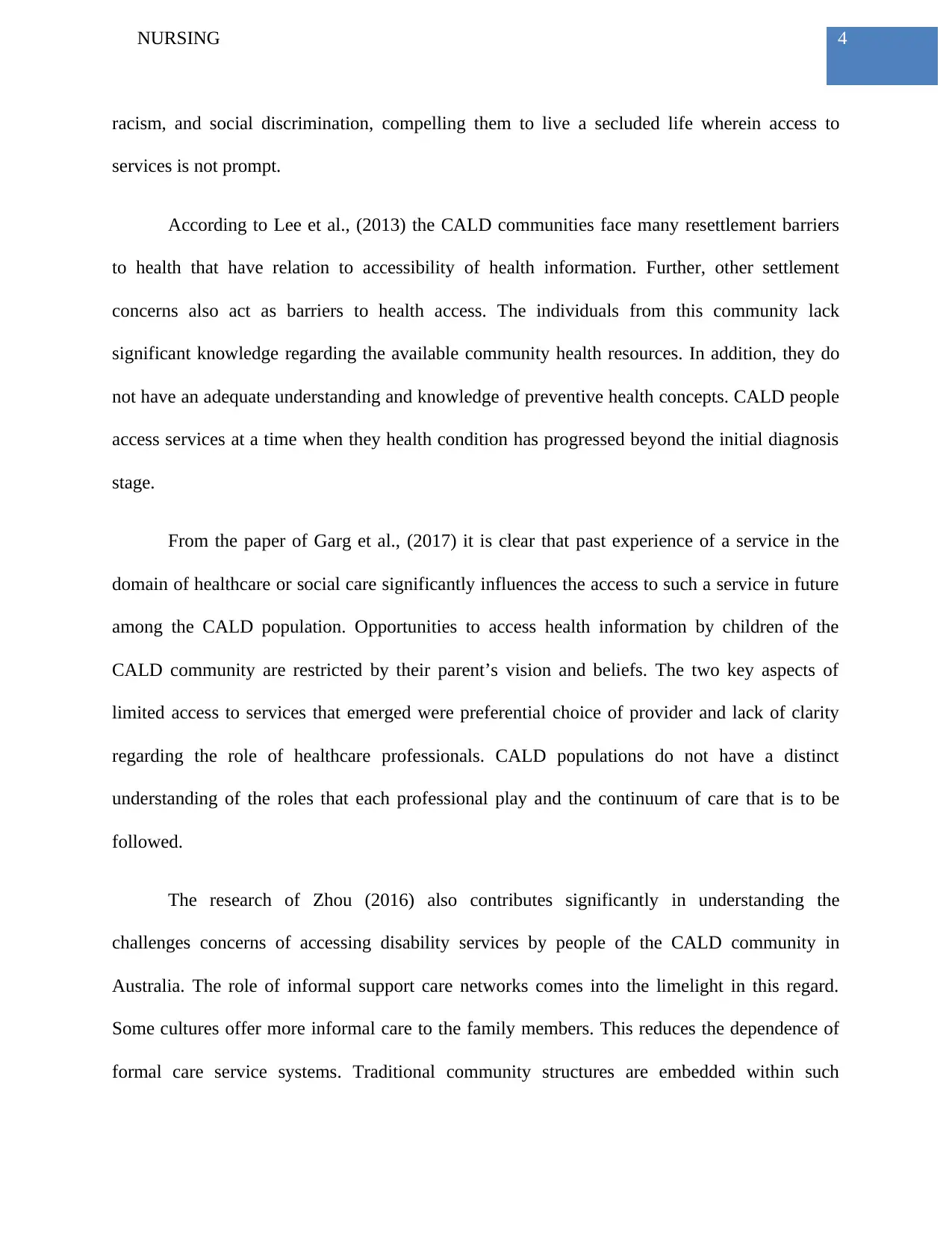
4NURSING
racism, and social discrimination, compelling them to live a secluded life wherein access to
services is not prompt.
According to Lee et al., (2013) the CALD communities face many resettlement barriers
to health that have relation to accessibility of health information. Further, other settlement
concerns also act as barriers to health access. The individuals from this community lack
significant knowledge regarding the available community health resources. In addition, they do
not have an adequate understanding and knowledge of preventive health concepts. CALD people
access services at a time when they health condition has progressed beyond the initial diagnosis
stage.
From the paper of Garg et al., (2017) it is clear that past experience of a service in the
domain of healthcare or social care significantly influences the access to such a service in future
among the CALD population. Opportunities to access health information by children of the
CALD community are restricted by their parent’s vision and beliefs. The two key aspects of
limited access to services that emerged were preferential choice of provider and lack of clarity
regarding the role of healthcare professionals. CALD populations do not have a distinct
understanding of the roles that each professional play and the continuum of care that is to be
followed.
The research of Zhou (2016) also contributes significantly in understanding the
challenges concerns of accessing disability services by people of the CALD community in
Australia. The role of informal support care networks comes into the limelight in this regard.
Some cultures offer more informal care to the family members. This reduces the dependence of
formal care service systems. Traditional community structures are embedded within such
racism, and social discrimination, compelling them to live a secluded life wherein access to
services is not prompt.
According to Lee et al., (2013) the CALD communities face many resettlement barriers
to health that have relation to accessibility of health information. Further, other settlement
concerns also act as barriers to health access. The individuals from this community lack
significant knowledge regarding the available community health resources. In addition, they do
not have an adequate understanding and knowledge of preventive health concepts. CALD people
access services at a time when they health condition has progressed beyond the initial diagnosis
stage.
From the paper of Garg et al., (2017) it is clear that past experience of a service in the
domain of healthcare or social care significantly influences the access to such a service in future
among the CALD population. Opportunities to access health information by children of the
CALD community are restricted by their parent’s vision and beliefs. The two key aspects of
limited access to services that emerged were preferential choice of provider and lack of clarity
regarding the role of healthcare professionals. CALD populations do not have a distinct
understanding of the roles that each professional play and the continuum of care that is to be
followed.
The research of Zhou (2016) also contributes significantly in understanding the
challenges concerns of accessing disability services by people of the CALD community in
Australia. The role of informal support care networks comes into the limelight in this regard.
Some cultures offer more informal care to the family members. This reduces the dependence of
formal care service systems. Traditional community structures are embedded within such
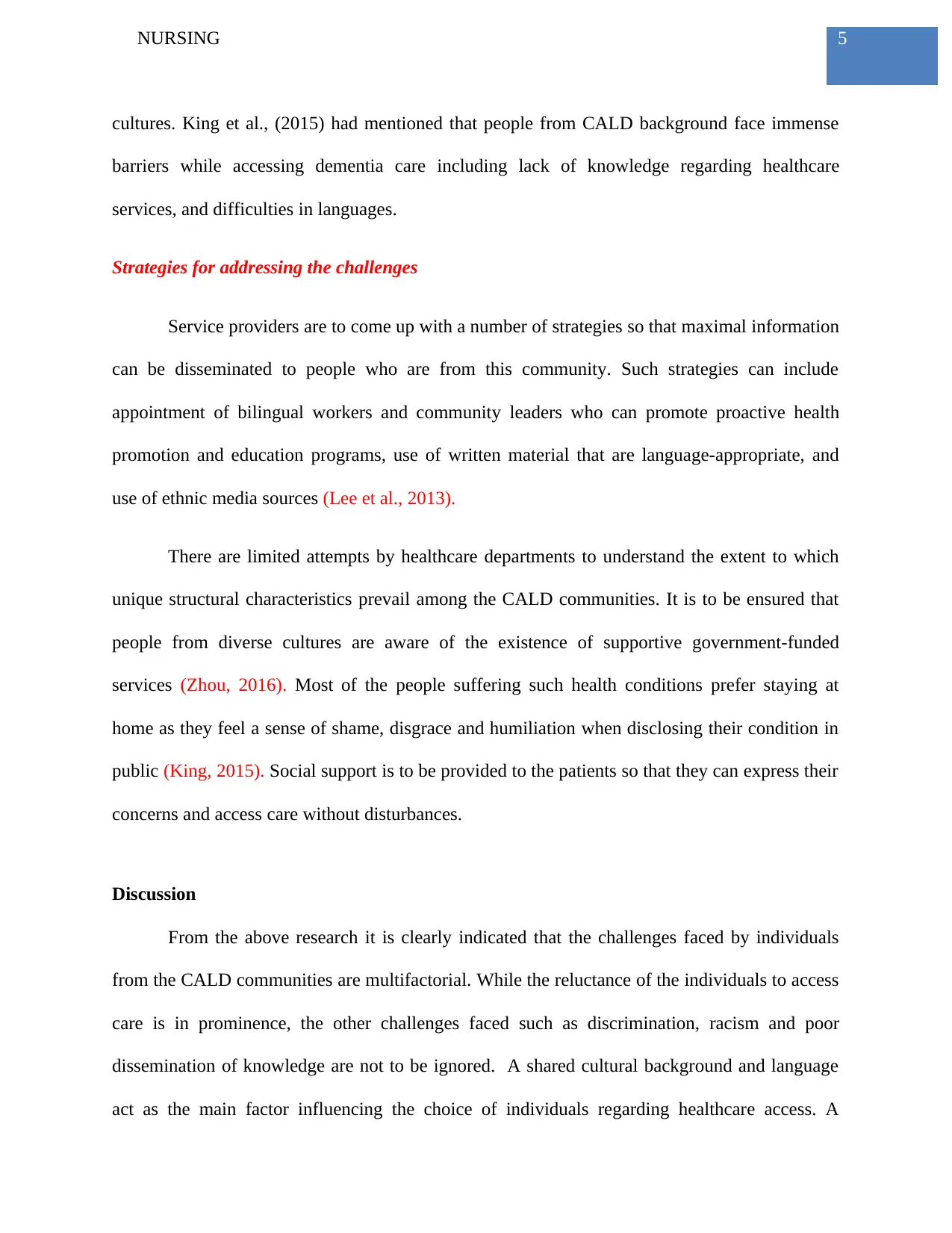
5NURSING
cultures. King et al., (2015) had mentioned that people from CALD background face immense
barriers while accessing dementia care including lack of knowledge regarding healthcare
services, and difficulties in languages.
Strategies for addressing the challenges
Service providers are to come up with a number of strategies so that maximal information
can be disseminated to people who are from this community. Such strategies can include
appointment of bilingual workers and community leaders who can promote proactive health
promotion and education programs, use of written material that are language-appropriate, and
use of ethnic media sources (Lee et al., 2013).
There are limited attempts by healthcare departments to understand the extent to which
unique structural characteristics prevail among the CALD communities. It is to be ensured that
people from diverse cultures are aware of the existence of supportive government-funded
services (Zhou, 2016). Most of the people suffering such health conditions prefer staying at
home as they feel a sense of shame, disgrace and humiliation when disclosing their condition in
public (King, 2015). Social support is to be provided to the patients so that they can express their
concerns and access care without disturbances.
Discussion
From the above research it is clearly indicated that the challenges faced by individuals
from the CALD communities are multifactorial. While the reluctance of the individuals to access
care is in prominence, the other challenges faced such as discrimination, racism and poor
dissemination of knowledge are not to be ignored. A shared cultural background and language
act as the main factor influencing the choice of individuals regarding healthcare access. A
cultures. King et al., (2015) had mentioned that people from CALD background face immense
barriers while accessing dementia care including lack of knowledge regarding healthcare
services, and difficulties in languages.
Strategies for addressing the challenges
Service providers are to come up with a number of strategies so that maximal information
can be disseminated to people who are from this community. Such strategies can include
appointment of bilingual workers and community leaders who can promote proactive health
promotion and education programs, use of written material that are language-appropriate, and
use of ethnic media sources (Lee et al., 2013).
There are limited attempts by healthcare departments to understand the extent to which
unique structural characteristics prevail among the CALD communities. It is to be ensured that
people from diverse cultures are aware of the existence of supportive government-funded
services (Zhou, 2016). Most of the people suffering such health conditions prefer staying at
home as they feel a sense of shame, disgrace and humiliation when disclosing their condition in
public (King, 2015). Social support is to be provided to the patients so that they can express their
concerns and access care without disturbances.
Discussion
From the above research it is clearly indicated that the challenges faced by individuals
from the CALD communities are multifactorial. While the reluctance of the individuals to access
care is in prominence, the other challenges faced such as discrimination, racism and poor
dissemination of knowledge are not to be ignored. A shared cultural background and language
act as the main factor influencing the choice of individuals regarding healthcare access. A
⊘ This is a preview!⊘
Do you want full access?
Subscribe today to unlock all pages.

Trusted by 1+ million students worldwide
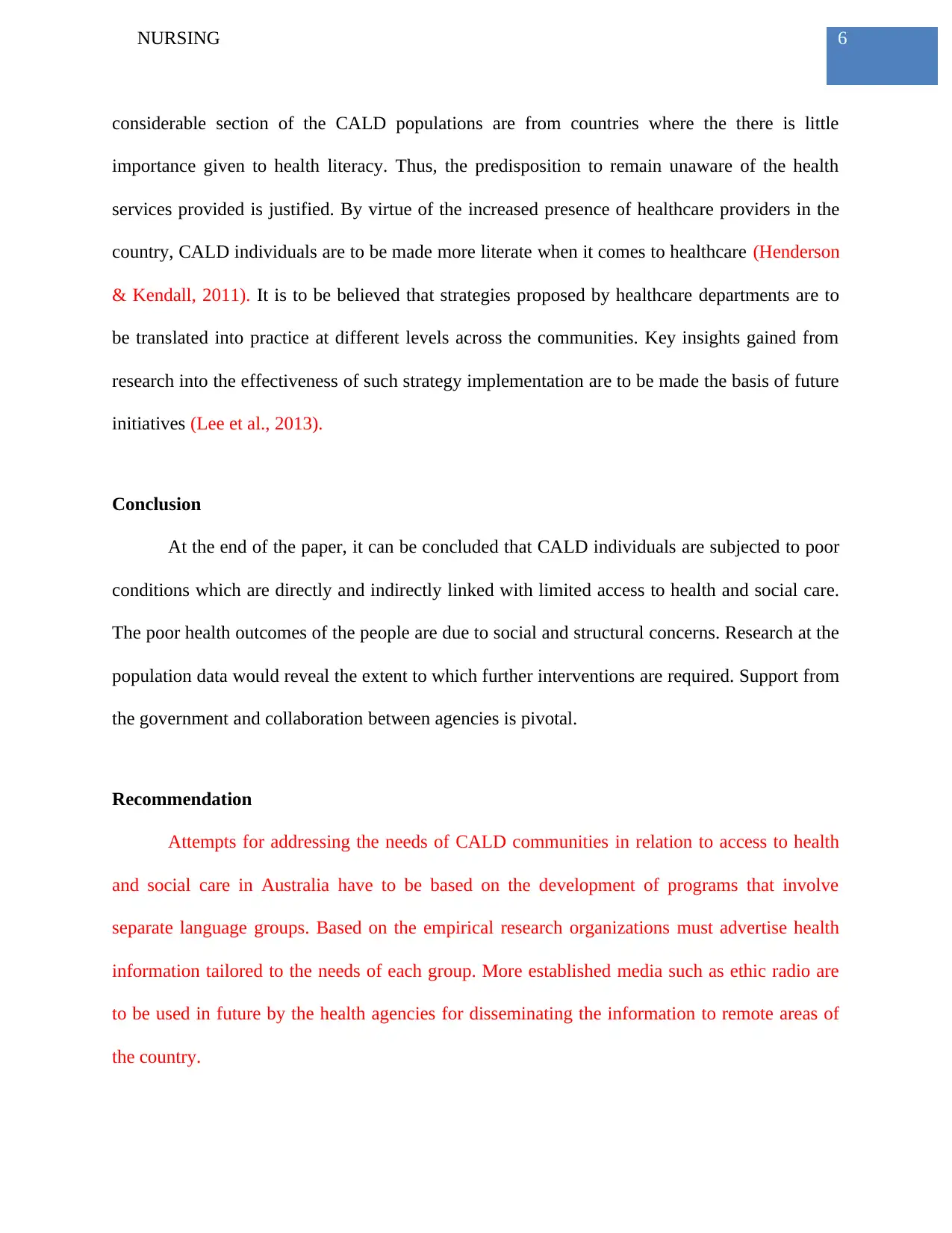
6NURSING
considerable section of the CALD populations are from countries where the there is little
importance given to health literacy. Thus, the predisposition to remain unaware of the health
services provided is justified. By virtue of the increased presence of healthcare providers in the
country, CALD individuals are to be made more literate when it comes to healthcare (Henderson
& Kendall, 2011). It is to be believed that strategies proposed by healthcare departments are to
be translated into practice at different levels across the communities. Key insights gained from
research into the effectiveness of such strategy implementation are to be made the basis of future
initiatives (Lee et al., 2013).
Conclusion
At the end of the paper, it can be concluded that CALD individuals are subjected to poor
conditions which are directly and indirectly linked with limited access to health and social care.
The poor health outcomes of the people are due to social and structural concerns. Research at the
population data would reveal the extent to which further interventions are required. Support from
the government and collaboration between agencies is pivotal.
Recommendation
Attempts for addressing the needs of CALD communities in relation to access to health
and social care in Australia have to be based on the development of programs that involve
separate language groups. Based on the empirical research organizations must advertise health
information tailored to the needs of each group. More established media such as ethic radio are
to be used in future by the health agencies for disseminating the information to remote areas of
the country.
considerable section of the CALD populations are from countries where the there is little
importance given to health literacy. Thus, the predisposition to remain unaware of the health
services provided is justified. By virtue of the increased presence of healthcare providers in the
country, CALD individuals are to be made more literate when it comes to healthcare (Henderson
& Kendall, 2011). It is to be believed that strategies proposed by healthcare departments are to
be translated into practice at different levels across the communities. Key insights gained from
research into the effectiveness of such strategy implementation are to be made the basis of future
initiatives (Lee et al., 2013).
Conclusion
At the end of the paper, it can be concluded that CALD individuals are subjected to poor
conditions which are directly and indirectly linked with limited access to health and social care.
The poor health outcomes of the people are due to social and structural concerns. Research at the
population data would reveal the extent to which further interventions are required. Support from
the government and collaboration between agencies is pivotal.
Recommendation
Attempts for addressing the needs of CALD communities in relation to access to health
and social care in Australia have to be based on the development of programs that involve
separate language groups. Based on the empirical research organizations must advertise health
information tailored to the needs of each group. More established media such as ethic radio are
to be used in future by the health agencies for disseminating the information to remote areas of
the country.
Paraphrase This Document
Need a fresh take? Get an instant paraphrase of this document with our AI Paraphraser
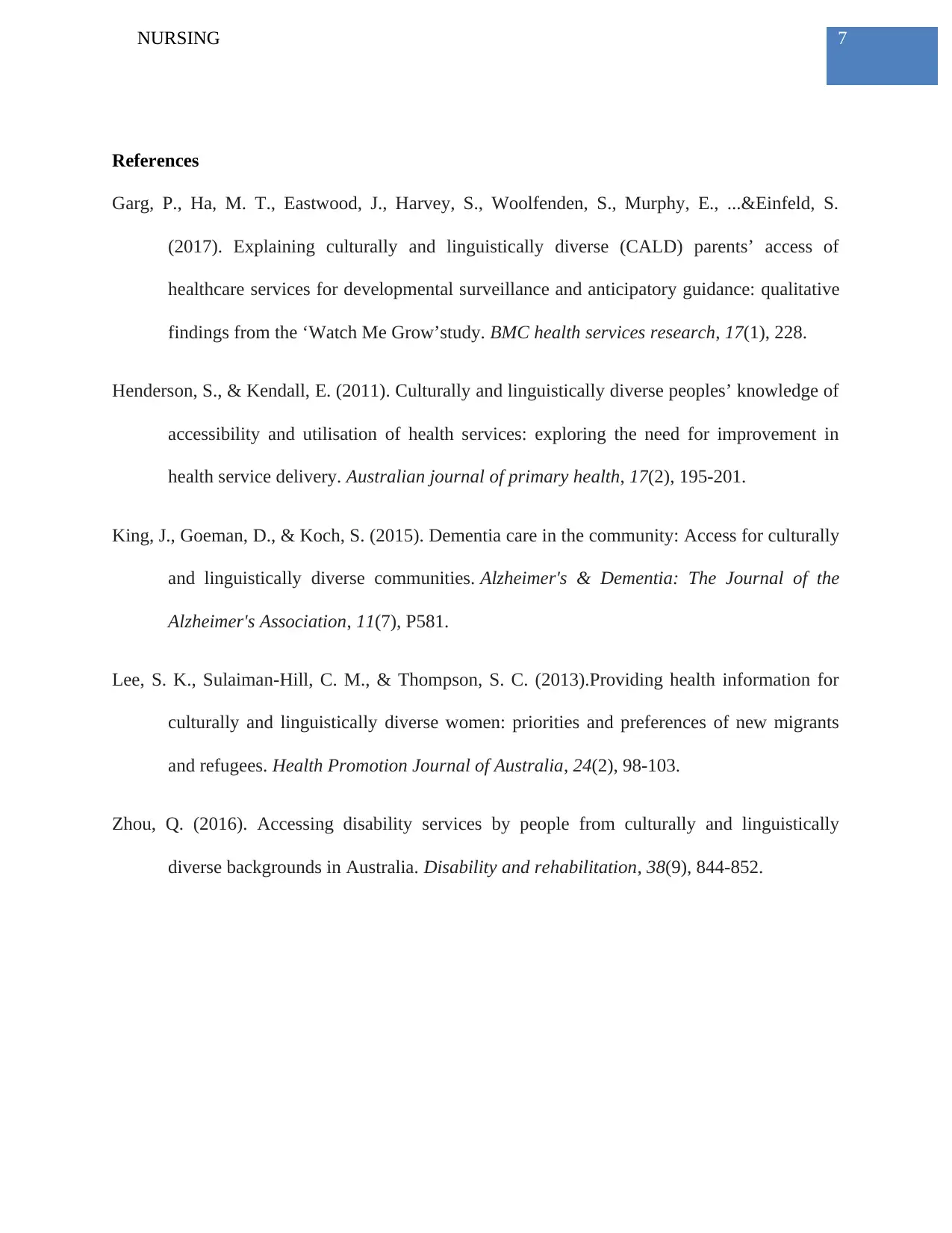
7NURSING
References
Garg, P., Ha, M. T., Eastwood, J., Harvey, S., Woolfenden, S., Murphy, E., ...&Einfeld, S.
(2017). Explaining culturally and linguistically diverse (CALD) parents’ access of
healthcare services for developmental surveillance and anticipatory guidance: qualitative
findings from the ‘Watch Me Grow’study. BMC health services research, 17(1), 228.
Henderson, S., & Kendall, E. (2011). Culturally and linguistically diverse peoples’ knowledge of
accessibility and utilisation of health services: exploring the need for improvement in
health service delivery. Australian journal of primary health, 17(2), 195-201.
King, J., Goeman, D., & Koch, S. (2015). Dementia care in the community: Access for culturally
and linguistically diverse communities. Alzheimer's & Dementia: The Journal of the
Alzheimer's Association, 11(7), P581.
Lee, S. K., Sulaiman-Hill, C. M., & Thompson, S. C. (2013).Providing health information for
culturally and linguistically diverse women: priorities and preferences of new migrants
and refugees. Health Promotion Journal of Australia, 24(2), 98-103.
Zhou, Q. (2016). Accessing disability services by people from culturally and linguistically
diverse backgrounds in Australia. Disability and rehabilitation, 38(9), 844-852.
References
Garg, P., Ha, M. T., Eastwood, J., Harvey, S., Woolfenden, S., Murphy, E., ...&Einfeld, S.
(2017). Explaining culturally and linguistically diverse (CALD) parents’ access of
healthcare services for developmental surveillance and anticipatory guidance: qualitative
findings from the ‘Watch Me Grow’study. BMC health services research, 17(1), 228.
Henderson, S., & Kendall, E. (2011). Culturally and linguistically diverse peoples’ knowledge of
accessibility and utilisation of health services: exploring the need for improvement in
health service delivery. Australian journal of primary health, 17(2), 195-201.
King, J., Goeman, D., & Koch, S. (2015). Dementia care in the community: Access for culturally
and linguistically diverse communities. Alzheimer's & Dementia: The Journal of the
Alzheimer's Association, 11(7), P581.
Lee, S. K., Sulaiman-Hill, C. M., & Thompson, S. C. (2013).Providing health information for
culturally and linguistically diverse women: priorities and preferences of new migrants
and refugees. Health Promotion Journal of Australia, 24(2), 98-103.
Zhou, Q. (2016). Accessing disability services by people from culturally and linguistically
diverse backgrounds in Australia. Disability and rehabilitation, 38(9), 844-852.
1 out of 8
Related Documents
Your All-in-One AI-Powered Toolkit for Academic Success.
+13062052269
info@desklib.com
Available 24*7 on WhatsApp / Email
![[object Object]](/_next/static/media/star-bottom.7253800d.svg)
Unlock your academic potential
Copyright © 2020–2025 A2Z Services. All Rights Reserved. Developed and managed by ZUCOL.





